Buying a Catamaran in 10 Steps – Complete 2024 Guide.
“We will live on a boat, but only if you buy a catamaran!” Our kids declared their wish (in surprising consensus) from the deck of our monohull.
We had to deliver. And we did.
We sold our house, cleared all debt and bought a catamaran.
With our extremely limited budget, confusing time frame, in the height of the COVID pandemic, we made it work. Here is what we learned along the way, mistakes we made and our tips for you.
All human-generated, all based on our real, personal experience.
Here are all of our Boat Life posts.
1. Browse Catamarans
When searching for a boat, visit the obvious and popular websites, but think outside the box too. The best deals might be hidden treasures. Read browsing ideas below:
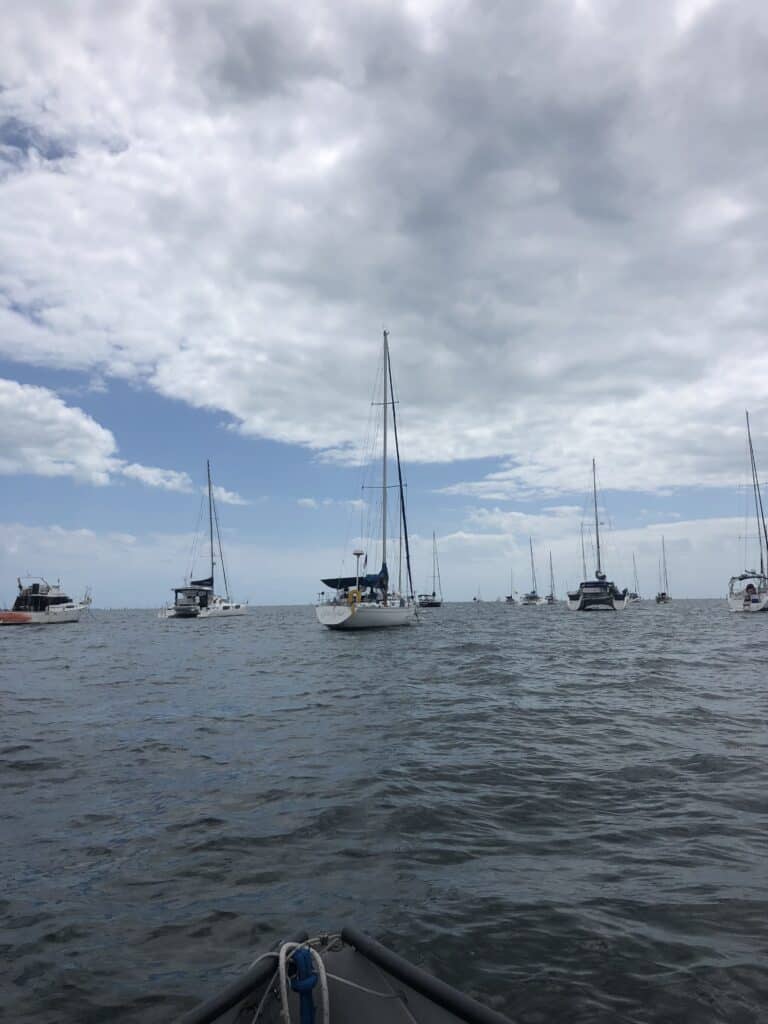
Boat Shows
Boat shows are our favorite places to compare brands and models and grab essential boat gear at a discount.
We have attended both the Annapolis and the Miami boat shows and highly recommend them. Miami is a bit busier, but there is a wider selection.
All the boats at boat shows were out of our price range, but this is how we decided we did not care for the angular Fountaine Pajot and the captain was too tall for most Lagoons.
Boater’s Tip: Boat shows gather cruising communities and are excellent places to meet other boaters-to-be.
Friends and neighbors
While looking for a catamaran, we had a bit of an unfair advantage. We had already lived on a boat for two years and had lots of boating friends.
But boating friends can be found anywhere. Join the boating communities on Facebook, attend gatherings and before you know it, you will be invited to tour any boat.
Just ask.
Our catamaran was not listed for sale. We found it by asking a listing agent, who happened to know that it was for sale and connected us with the owners.
Boater’s Tip: Take a walk in a water-front neighborhood and ask a few people if they know of any neighbors selling their boat.
How about some inspiration?
45 Epic Sailing Movies We Will Watch Over and Over…
85 Beloved Sailing Songs (and Karaoke). The Only Playlist you Need.
81 Best Sailing Quotes & Captions. Stuff Boaters Really Say.
For-sale-by-owner websites
A few websites offer listings of catamarans for sale by owner. We toured them all, while searching for our cat.
Here are a few to browse:
- Catamarans For Sale By Owner – CatamaranSite
- Catamaran Sailboats for sale by owner – Boat Trader
- Catamarans For Sale By Owner | Catamaran Guru
YouTube
YouTube is a great place to watch tours of various models. With boating becoming quite popular, many people document their adventures aboard their catamarans.
Our YouTube Channel helped us sell our Privilege.
Pick a few channels closer to your kind of adventure (solo, couple, family) and follow them. We had a couple favorite channels, which we used to get some idea of boat life.
Boater’s Tip: If sailing with kids, screen a few episodes to ensure they are kid friendly. People do all kinds of nonsense, to get a few extra “likes”.
Facebook Groups
Facebook groups are another great resource for finding catamarans. We had lots of responses, when we decided to sell ours. People are very active on these groups.
Here are a few to join and start browsing:
- Catamarans for Sale | Facebook
- Catamarans For Sale by Owner – Worldwide | Facebook
- Catamarans For Sale Worldwide By Owners | Facebook
Brand Websites
Of course, the classic boat browsing Yachtworld is a great resource for finding catamarans.
If you know the brand you like the most, you can also sign up directly with the manufacturer, they usually have a newsletter.
They will send you recent price drops.
2. Choose the Right Boat.
When deciding on the right cat for you, budget does not always come first. Keep in mind the following:
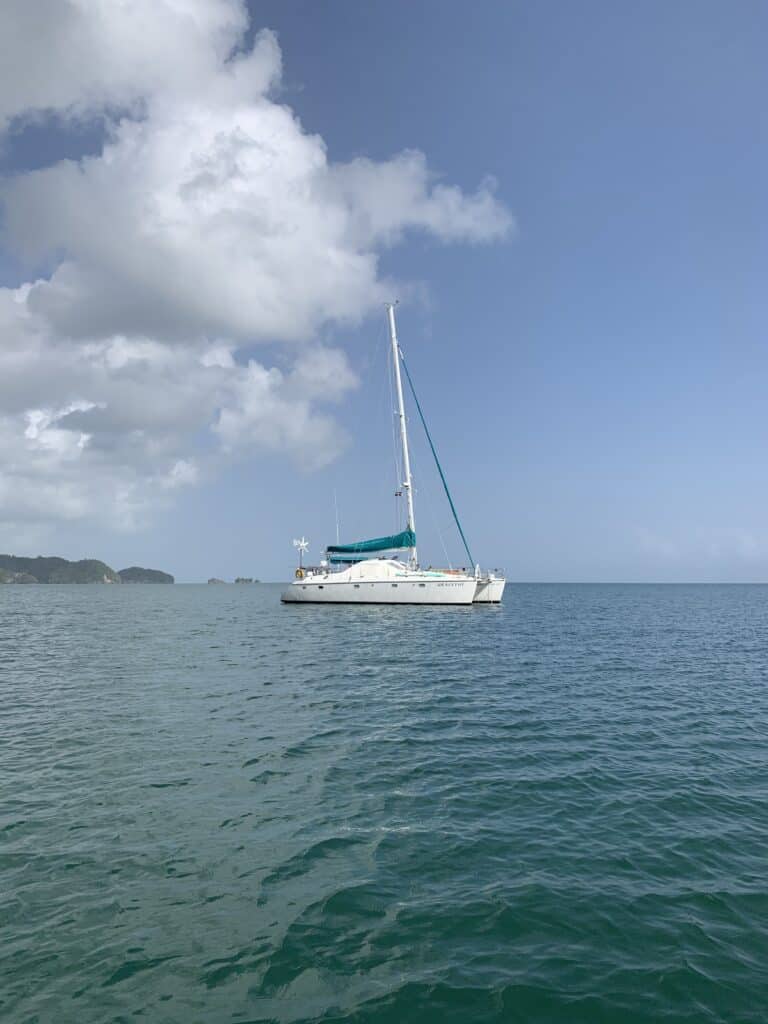
Sabbatical vs indefinitely.
If you are making arrangements for just a few months, or a year of living on a catamaran, making the best out of the short time aboard is a must.
Reselling a catamaran after a year is much easier, than after five or ten. Look for a catamaran that requires as little work as possible (they all will require work).
But do not rush into boat purchases. There are plenty for sale.
Boater’s Tip: Always add at least a couple of months to your cruising start date, and work backwards, when planning repairs and upgrades.
Time before sailing away.
If you have time to buy a catamaran and fix it for a few months, or even a year, you will have time to finish all the work before you start cruising.
Any boat will require work, regardless of age and condition.
We were stuck with a monohull and a catamaran for a bit, which was not ideal, but we did not want to be rushed into buying a catamaran, just because we had no place to live.
Boater’s Tip: Not being pressed for time will greatly reduce your initial cost and will grant you more negotiating power.
Helpful money posts:
I Don’t Think I Can Live Without… Think Again. How to Remove Suburbia Stuff and Travel.
The Cost of Living on a Boat for our Family of Five
Budget
The time you plan to spend cruising and preparing the boat will influence your budget.
A well-outfitted catamaran, around 42-44 feet will cost you at least $250K, for an older boat (early 2000’s). For a 3-4 year-old boat, 46 feet or larger, prepare around half a million.
Catamarans are becoming more desired each cruising season, so they tend to hold their price.
We wanted a catamaran under $80 000, but we had no established end date for cruising. And the work it required pushed us back more than half a year. We lived in a boat yard for five months.
Boater’s Tip: Catamarans are popular. You might be able to resell at a minimal loss. Or break even, if you are lucky. Or make money, if you are prone to miracles.
Old vs New
We think that buying an older boat is better. New boats will have problems too, and repairs are waiting for you. Add these to the already high price tag.
Older boats have been handled by a few captains, and might leave a surprising collection of half-finished upgrades, but they have proven themselves in the water.
Our buyer sent us the deposit and did not ask for a survey at all, because Joe was able to deliver the cat with a 7-day sail.
If the boat can handle that well and a family lived on it – what more can you ask for?
Ultimately, price is a defining factor for many new boat owners, taking new boats out of the equation fairly quickly.
Boater’s Tip: The boaters might have a YouTube channel, so you can see the boat in action.
Brand
We love Privilege, and we toured tons of boats (in our price range). Privilege offers the perfect compromise between comfort and performance.
Since we lived on and sailed a Privilege, we can attest to their cruising comfort and speed when needed, while keeping the crew happy.
Lagoons and Leopards are the so-called production boats. They are very popular and offer a nice variety at more affordable prices. Speed-sailors call them “condomarans”…
Cruising life is over 90% at anchor, so where are you rushing to?
At the other end are the performance boats, Catana, HH, Outremer, and others. They are known for their speed, sometimes at the expense of the perfect 360 view (the salon sits lower). They are also more expensive.
Boater’s Tip: Production boats offer a greater variety of affordable choices. On the flip side, they are your classic chartered boats.
Buying a Chartered Boat.
Many of the so-called production catamarans are formerly charter boats, as the companies are updating their fleet.
If the catamaran was managed well, buying a previously chartered boat is a good option.
However, keep in mind that these boats are outfitted for a brief fun-in-the-sun vacation, not liveaboard life. You will probably need to spend money to outfit the boat for long-term cruising.
Helpful posts – Boat Gear and Gadgets
We prefer to look for boats previously owned by a single owner. Especially families. Families tend to take care of their boats.
But, it might be hard to trace back all the owners and all the repairs and upgrades they made.
Boater’s Tip: If buying a boat off of charter, research the charter company and buy from a reputable and well-reviewed one.
Stationary vs Cruising Lifestyle.
If planning to live at a marina, you can think of your catamaran as a small apartment. The boxy design of newer catamarans makes them excellent for living on anchor, or at a marina.
If you plan to cruise a lot, you should consider the performance as well. Cruising comfort can make or break a dream.
We have seen it.
Then again, if you have not sailed different cats, there is no basis for comparison.
Boater’s Tip: Any passage, on any boat will make you seasick. Do not let that affect your decision.
Outfitting the boat.
If you are not planning on cruising much, then solar panels, water-maker and a good dinghy will not be too high on your list. These can all be added later.
If you plan to leave asap, or want that one year of a perfect cruising time aboard, look for a catamaran already outfitted for blue-water cruising:
Ask and inspect for:
- Solar power
- Batteries age and condition
- Wind turbine
- Generator (you do not need one)
- Navigation instruments
- Dinghy in good condition.
Our super low budget meant we had to upgrade all the systems. Unfortunately, we sacrificed cruising time for this.
Number of people aboard.
If sailing as a couple, or solo, a 38-40ft catamaran should be more than enough. However, if sailing solo, we believe a monohull is the way to go.
If living on a catamaran with a family, I would look for at least a 42 ft boat. They will still allow for a good layout and separation of space, while also offering comfortable cruising.
With five of us aboard, our Privilege 42 worked great.
Boating friends of ours chased their dreams on a 39ft boat. Spending 6 months on land, and the other 6 exploring the Caribbean and beyond. There are many ways to cruise.
Boater’s Tip: Younger kids can share a cabin; some might decide to sleep in the salon. Older kids will be grateful for privacy.
Layout
Number of cabins, location of the galley, soft vs hard bimini, ease of handling the main sail and location of the helm/s – all matter in the long run.
Do you want three or four (or five) cabins? On many cats, one of the hulls is an owner’s suite, with a cabin, a spacious bathroom and even a small nook for an office.
This layout might be easier to re-sell, especially if it is a smaller boat. Many young, or retired couples prefer this.
We were looking for a 4-cabin layout, having three older kids. We wanted each to have their private space.
Fun fact – the only time our kids had separate rooms, was while living on a catamaran. All our land homes have been with 2, or 3 bedrooms.
Another consideration is the galley – above or below. Below is not as popular, but frees up space in the salon. It is my preferred option and another reason why we love Privilege.
The cockpit and the bimini cover are a big deal, if sailing in the tropics. Hard bimini offers much better protection from the elements.
No matter how well we coated our soft bimini to waterproof it, nothing worked for very long, against the torrential rains of the Caribbean.
Boater’s Tip: Think about reselling too. Many people like the galley above, hard bimini and an owner’s suite.
Captain’s height.
With Joe being 6’4”, I have to mention ceiling height. If you are not able to fit inside your own home, it will start bothering you.
To be fair, most guys have such a strong urge to sail the seas, that the clearance might not be bothering them too much.
Or, maybe, it was just my husband.
Regardless of the boat size, the outdoors more than compensates for tiny indoor spaces.
3. Where in the World are the Deals?
The cheapest catamarans are in the Mediterranean, especially the south-east seas.
The best variety and options are in the US. The Bahamas and the Caribbean are also great shopping destinations.
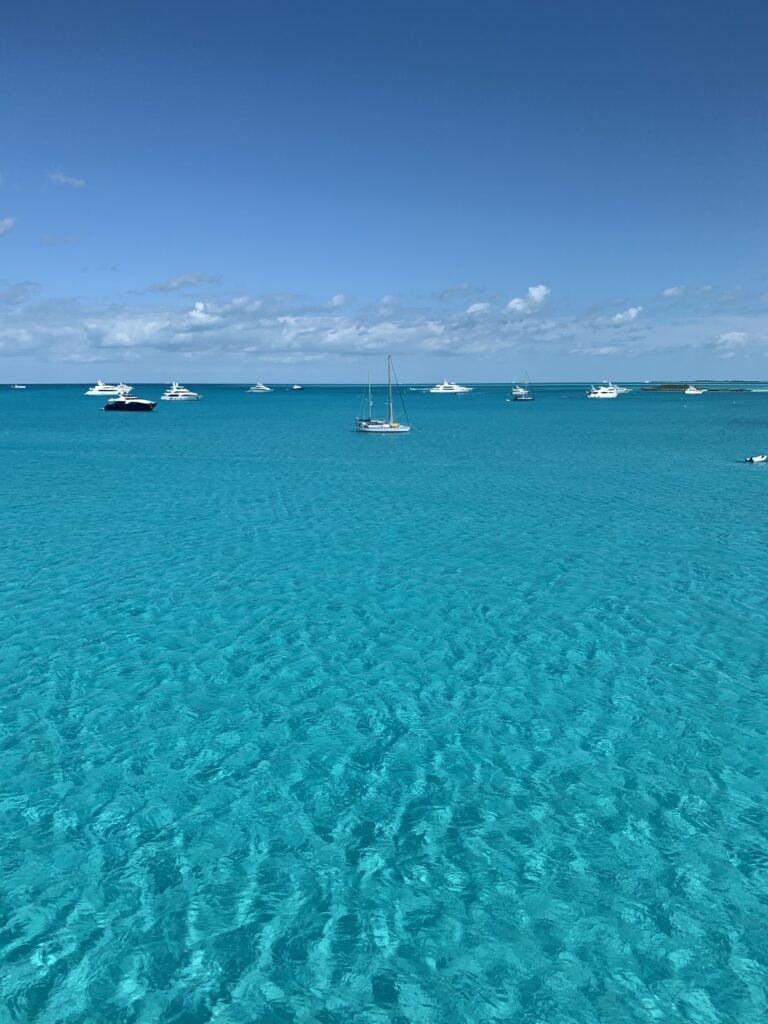
You might think that a boat for sale in the islands is cheaper, because of the logistics associated with touring it.
However, many people would gladly fly to start their adventure in the islands, so these catamarans tend to hold their prices.
Buying a boat in Europe might mean VAT (value added tax) of 20% must be paid on of the sales price. It only needs to be paid once, so it will be advertised in the listing.
Boater’s Tip: The US has the greatest selection and the highest prices. Alternatively, negotiate the price down and have it delivered.
4. Broker or No Broker?
We have experience with both. We have purchased and sold with a broker. We have also purchased and sold by owner.
What should you do?
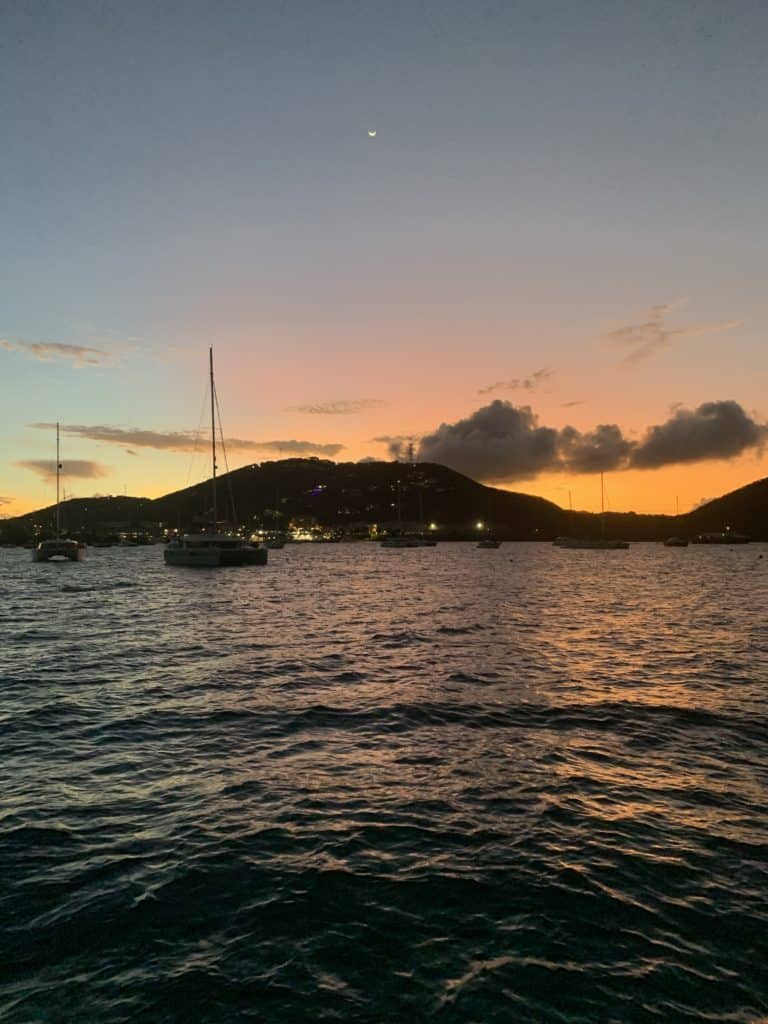
Buying with a broker.
Boat brokers have high commissions, so a good broker should be able to:
- Compare catamaran models and years,
- Spot potential money-pits,
- Know your wishes and priorities,
- Research the history of the boat,
- Negotiate prices,
- Send you photos,
- Offer a video tour
- Advise you on payment options
- Advise you on insurance options
- Handle all the logistics regarding haul-out, sea trial, boat touring.
A broker can be very helpful, if browsing boats hundreds of miles away from your home.
We bought our first boat with a broker, because we had no idea what we were looking for. We also sold that boat with a broker, because we were very far from the Chesapeake at that time.
Boater’s Tip: If you are completely new to boating, finding a trustworthy broker can be a sanity-saver. Ask in Facebook groups.
No brokers involved.
We purchased our second boat without a broker. We liked the process much better. And the savings even more.
If we buy another boat, we will bypass the brokers again. We used an agency for all of the deposits, paperwork and payment.
While it is definitely more work, you lay eyes on a lot of boats and learn how to trust/not trust sellers.
Expect a lot of driving (even flying) involved.
After seeing the first boat and realizing the photos online were of what the boat “can really look like”, we knew to ask for live video the following time. After stepping in a boat, which felt terribly wet, we knew what a wet boat left like.
Boater’s Tip: Hire an agency to help you properly execute the sale. They handle all of the paperwork and transfer of funds.
5. Inspect Before You Pay.
Photos, videos and tours – it is all part of the buying process. Do not skip a step.
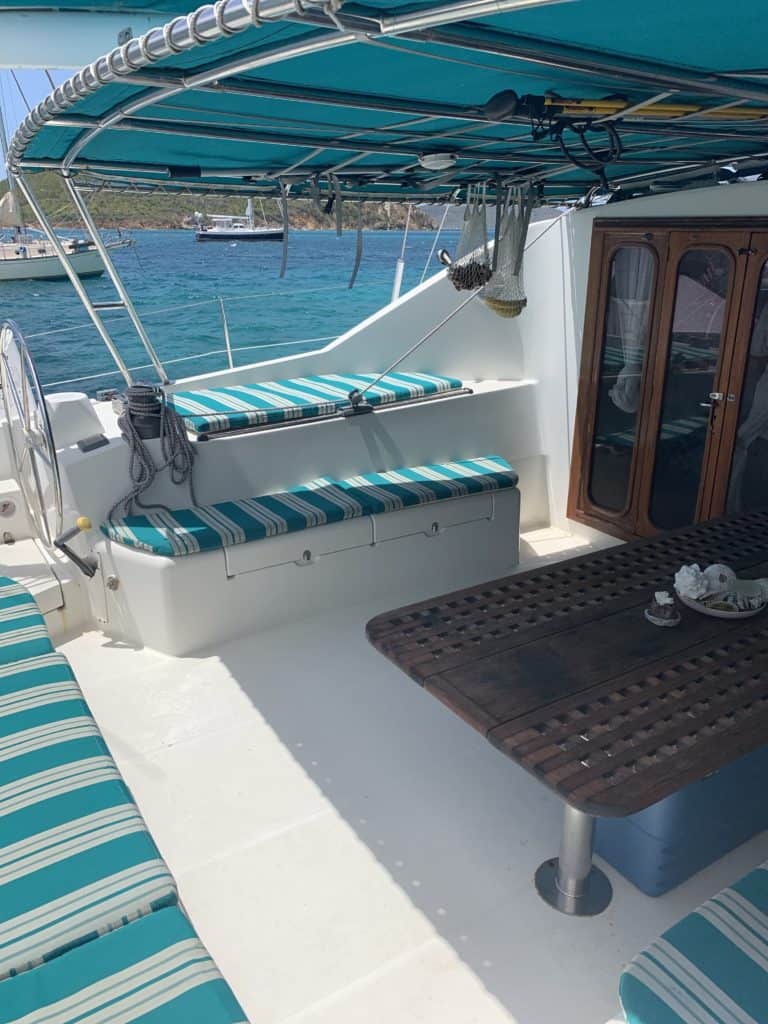
Survey
If you know what you are looking for, and have had boats before, buying a catamaran is not that much different from buying a monohull.
Speaking of comparing: Catamaran vs Monohull: Let’s Solve This (we Lived on Both).
Ask about the latest survey, the boat owner should have it.
If you want your boat insured, you will need to have a survey. If you want to stay at any marina, at any point in time, you will need insurance.
Since a survey sounds like a must-have, hire a professional who knows what to look for, and is familiar with the brand you are buying. Do not rely on your broker to find a surveyor, we made that mistake once.
Boater’s Tip: Go on Facebook, find catamaran cruising groups and ask for surveyor recommendations.
Expectations
Even if the survey comes back beautiful and you have as close to a turn-key boat as you can wish for, expect problems.
There is always something that cannot be caught during a survey. Work on a boat never stops.
Boater’s Tip: Fill your wallet with $1000 bills.
See the boat personally.
Always, regardless of location. Fly if you have to. I cannot tell you how many photos on the most reputable websites do not match the real condition of the boat.
We drove all the way to Key West, Florida, to look at a boat, after multiple talks over the phone. For us the drive was from northern Virginia.
We arrived to find a family who had turned the boat into a floating house, and we would have had to redo and rewire everything to be suitable for blue-water cruising.
Video Tour
If the boat is in a remote location, it is perfectly reasonable to request a video tour of the boat.
I recorded one when we listed ours from USVI. It also helped that we had a YouTube channel, so the potential buyers could see us cruising and living aboard.
Boater’s Tip: Every other cruiser has a YouTube channel these days. Ask for it and watch their videos.
Do not trust photos alone.
Look at photos with a grain of salt. Make that two grains. Photos are great to give you some idea of what the boat looks like.
If a broker is involved, you can breathe a sigh of relief. The photos should show the actual condition of the multihull. If otherwise, your broker should disclose that.
Questions to ask.
Here is a list of questions to ask the boat owner/broker:
- Why are you selling?
- What is the HIN (hull identification number)?
- What are the current projects to complete?
- Condition of the engines and any service done.
- Latest Haul-out and bottom paint.
- Latest rigging inspections.
- Hull
- Has the boat ever been in a major storm?
- Where has the boat sailed?
- What conveys?
- Condition of the dinghy and title.
- Number of previous owners (if known).
- How many years owned?
- Ask to see the captain’s log.
- All information to transfer ownership for AIS, EPIRB, Satellite trackers, radio license (single-band, complicated), etc.
After gathering all the information, do your homework and use the HIN to research the boat’s history and title.
6. The Sea Trial.
A sea trial is always a contingency when buying a boat.
We had one with our monohull, but not with our catamaran, because we purchased the boat as-is, where-is.
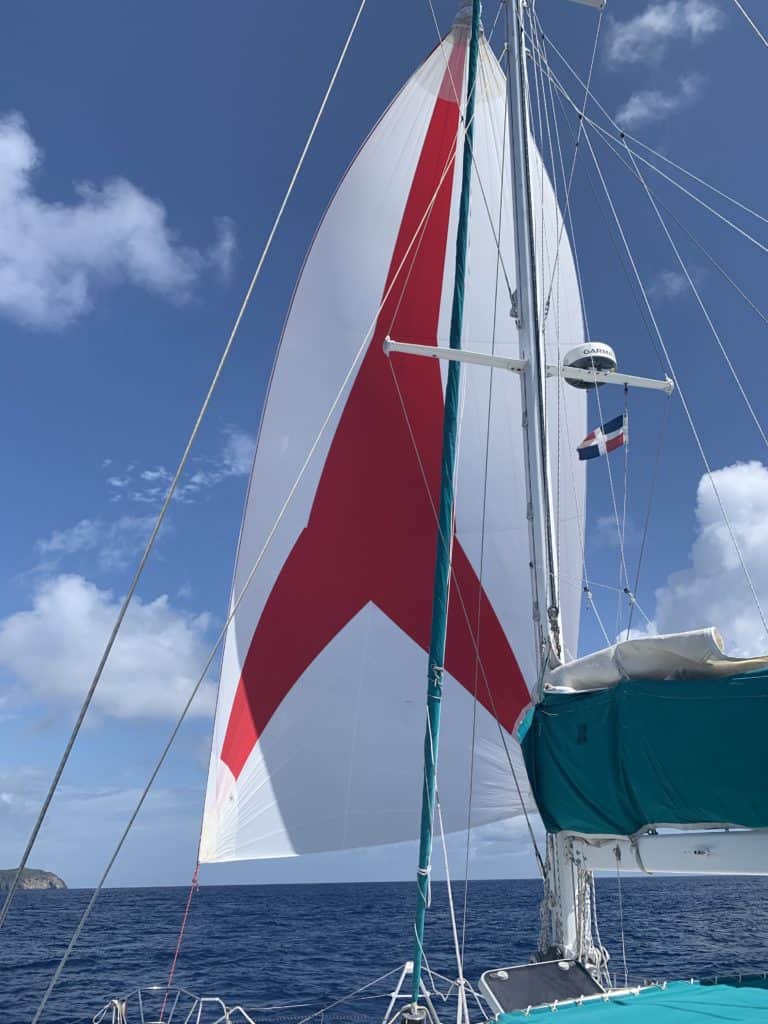
Ours was already at a marina, in the water. Quite a lot of water, actually. A bit was inside one of the engine rooms.
Learning about boats, speaking with other boat owners and knowing what to look for can be invaluable in such situations.
In-water inspection.
Once the boat is in the water, open every bilge, check every valve. Test the pumps. Sure, easy to replace, but also one fewer thing to worry about.
We found an entire roll of electrical tape holding one of the main cables, on top of the mast of our monohull. The surveyor never cared to check, and we did not know what we were doing.
Boater’s Tip: If possible, climb up the mast. It is hard to see everything from the bottom.
Test all the systems.
During the sea trial, raise the main sail, test the gib/genoa. If you can fly a spinnaker, even better. Although they take longer to take out and set up.
Try to take a sailing class, or two before a sea trial.
Try to schedule the sea trial according to the wind forecast, if possible. Some beam and downwind sailing would really help you feel the movement of the boat.
Boater’s Tip: If bringing the entire family for this, select a good day for downwind sailing, that’s when catamarans really shine.
Prepare yourself and the crew.
If purchasing the boat as a family, expect everyone to feel seasick during the seatrial.
If people do not feel sick with all the excitement during the short cruise – great. Just know that it is normal and does not mean you are not fit to live on a boat.
Wear comfortable clothes and shoes.
Here are a few helpful posts:
9 Sailing Outfits for any Season and Reason
Comfortable Sailing Shoes for Every Boating Need
Seasickness Sucks – 21 Tried and Tested Tips to Stop it.
7. Haul Out Inspection
You should have a haul-out inspection, unless you are buying it as-is, where-is. If so, you should dive and inspect the bottom yourself.
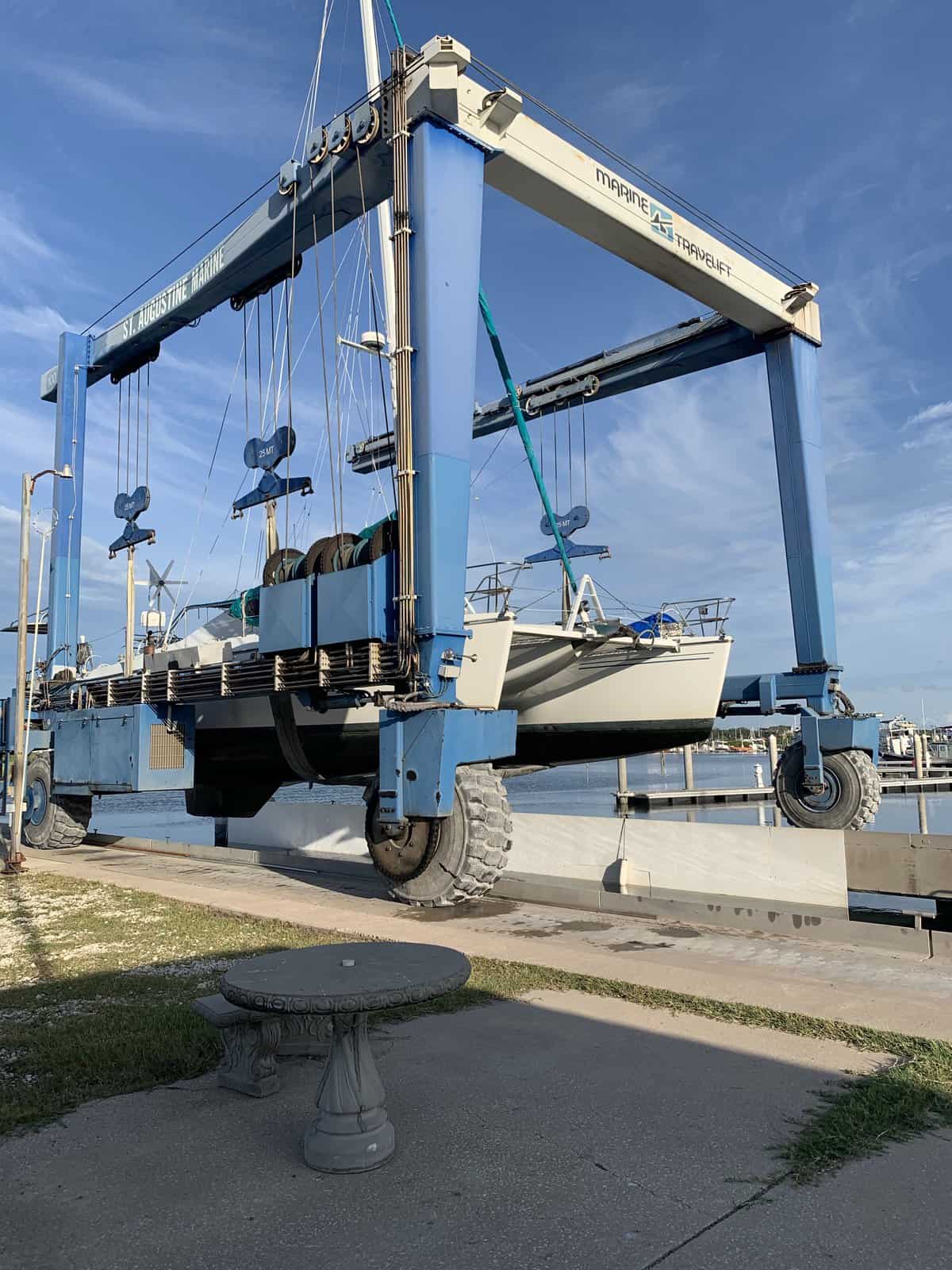
Ask for proof (receipts) of the latest haul-out and the work that was done. Haul-out and bottom paint should be done every two years, ideally.
If you are not familiar with inspecting for blisters, signs of delamination and such, find a good surveyor.
The person who was in charge of much of the work at our boat yard, in St. Augustine, was very skilled and gave us great tips.
Boater’s Tip: Get a second opinion from one of the people at the boat yard. They work on boats every day.
9. Paying for the Catamaran.
That dream is going to cost money. A lot of money. Below are tips to save you some of it.
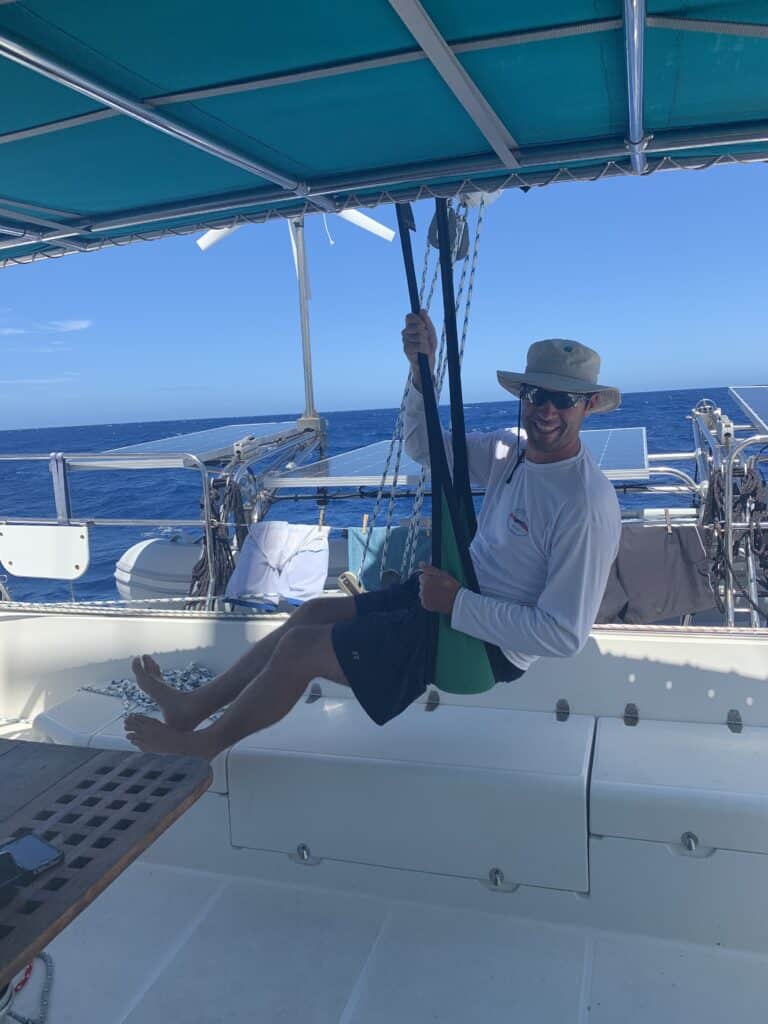
Negotiations
We are all for low-balling. Negotiate as much as you can. It might be irritating to boat owners, as it was for us, but it’s your hard-earned money.
You might lose a boat, or two, as did we, because others offered more. Don’t get caught in that game. New boats are listed for sale every single day.
Negotiations work best, if you are not pressed for time, or living arrangements. If at all possible, leave enough time (at least a few months) to look for boats, negotiate and find the best one for you.
Boater’s Tip: Many boats are sold at the end of the cruising season, so the owners would not have to deal with haul-out, storing and maintenance.
Putting down a deposit.
Expect to be asked to put down a deposit before you are able to have a sea trial. You should be able to go tour the boat without any financial obligation.
If it is a good boat, at a good price, you might want to put down a deposit before touring the boat. Just make sure it is in writing. Or, if working a broker, a form should be provided.
Paying with cash.
Paying with cash is a great option, to avoid interest.
It was one of our requirements, after we cleared all of our debt.
If paying cash, leave at least 5% of the boat value for unexpected repairs, in addition to the budgeted 10% and the funds for known repairs and upgrades.
Boat “mortgage”.
If you are turning your boat into your primary residence, even if just for a year, or two, taking out a mortgage makes sense.
Unfortunately, it is this trend, which keeps the catamaran prices high. We are not fans, but it is here to stay.
Unlike a mortgage on a house, expect a higher interest rate, and no monetary return on investment, when you decide to sell.
Having said that, can you put a price on the adventure of a lifetime?
Home equity loan.
If you need a loan, and a bit lower interest rate, a home equity loan might be the way to go.
It is how we purchased our first boat.
You will have your home on the line, but it is easier to obtain such a loan, versus a boat loan.
Boater’s Tip: Regardless of the type of loan you choose, leave enough cash for maintenance, upgrades and repairs.
Charter to own.
Quite a few chartering companies will allow you to have the catamaran for a certain portion of the year, while it is being chartered the rest of the time.
Over a few years, you should be able to have a fully paid-off boat to take anywhere in the world. Not a bad deal.
We met someone who did that and was happy with his decision.
On the flip side, you have to wait for a few years and those charter parties aboard can be rough on the boat.
Buying alone.
It is always easier to be the sole owner of the boat. Then every mistake you make is on you. Every decision you take will not be questioned by others (except for the crew).
Buying alone means all the expenses are on you, but so are the potential profits.
Boater’s Tip: Get a captain’s license and make money by offering charter trips, sunset cruises, Airbnb’s and so on.
Co-owning a boat.
Co-owning a boat would make sense, if all you want to do is spend some time aboard as a vacation. Then all the co-owners would divide the time.
It certainly makes the dream a lot more attainable, and you will be able to afford a larger and nicer boat.
The drawback of co-owning a boat is that when something needs to be fixed, or upgraded, it is not always easy for all the owners to agree.
Boater’s Tip: Have a contract listing how the boat and repairs will be shared. Do not rely on friendships alone.
10. Costs of Owning a Catamaran.
Below are a few expenses to consider before you are sold on the 360 view. Views do sell 🙂
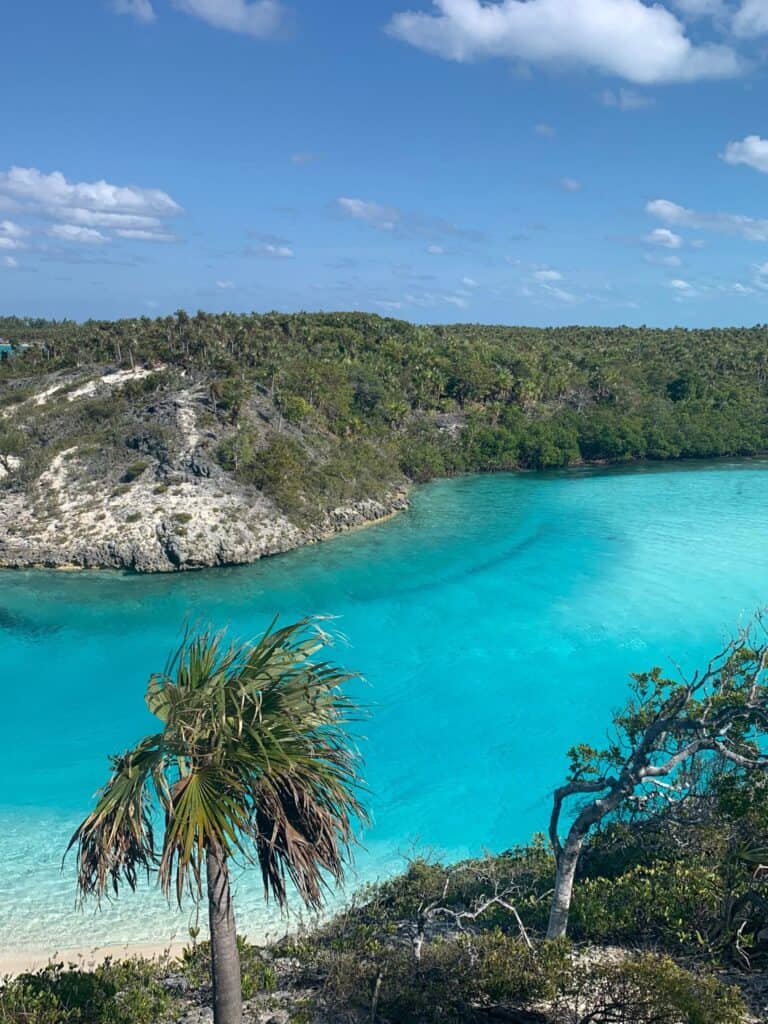
Insurance
Plan to have insurance in the US. Possibly abroad as well.
Insurance premium will probably be around 2% of the boat’s insured value, per year.
Keep in mind that the cost of having the boat insured in one cruising destination will be different from worldwide coverage.
We carried insurance with our monohull, because Joe was still working and we spent a lot of time at marinas. Once we left the Bahamas, on our catamaran, we dropped insurance and assumed the risk of losing our boat.
Since we owned and insured assets in the US, our umbrella policy provided liability coverage worldwide.
Boater’s Tip: You can buy local insurance in every country you visit, check with local marinas. It is usually cheaper.
Maintenance
Annual maintenance cost for a boat is usually around 10% of its value. However, this is maintenance cost, not upgrades.
If cruising, every system aboard must be working properly, which means regular maintenance and fixing things before they break.
A faulty valve can cause a boat to sink. Boat maintenance is a lot more involved than house maintenance.
On the other hand, you are using and relying on all boating systems daily. This makes it easy to spot a problem and fix it early.
Boater’s Tip: Buy spare parts and tools before you head over to small island countries.
Upgrades
We purchased our catamaran for less than 50K, but we had to install new engines, change all the piping, solar panels, replace all of the electronics, navigation and the dinghy.
Along with the cost of haul out to sand, paint and add a layer of fiberglass on the bottom – that was way more than 10% of the cost.
By the time we were done with everything, the boat was worth over 150K. We saved a lot by doing most of the work ourselves.
Boater’s Tip: Leave labor-intensive upgrades for abroad, where cost of labor is a lot lower than in the US.
Catamaran-specific costs
When buying a catamaran, prepare for costs associated specifically with a multihull.
You will have two engines to maintain. Two hulls to paint. Two AC units to care for (if using). A lot more hatches to fix, when leaking.
That 360-degree view comes through curved (on some models) windows, which are a nightmare to replace.
Haul-out of a catamaran requires a wider boat lift, excluding many of the boat yards.
Boater’s Tip: Don’t forget the trampolines, and spinnaker, which is such a thin, yet very frequently used sail.
Registration and Taxes
Since both our boats were USCG documented, we are most familiar with US laws.
The boat must also be state registered.
We chose Texas as our primary residence, and registered our boat there. It does not matter if the boat will ever be in that state.
Do not forget the dinghy, it is a boat as well, and it will need to be registered. State laws vary.
Boater’s Tip: Use a traveling mailbox service as your permanent residency address, if you do not have one.
Conclusion
Buying a catamaran is super exciting. In many cases it is a requirement for a boating dream to become a reality. Because she said so.
A catamaran will make an excellent family boat. It is safe, reliable and comfortable.
Sure, a cat might cost as much as a house, but can you take your house around the world?
Your Turn,
Let me know what your questions are, regarding buying a catamaran. Comment below. Please, be respectful, thanks.
